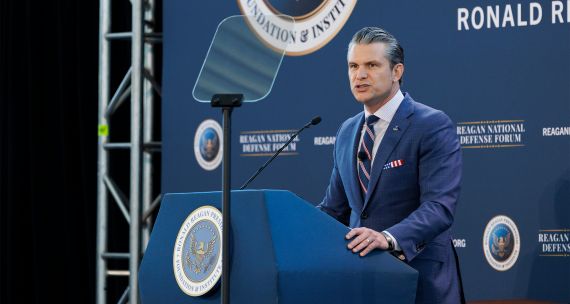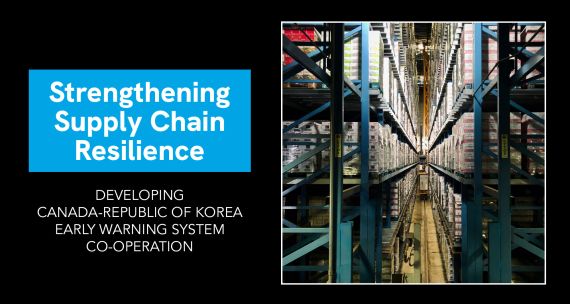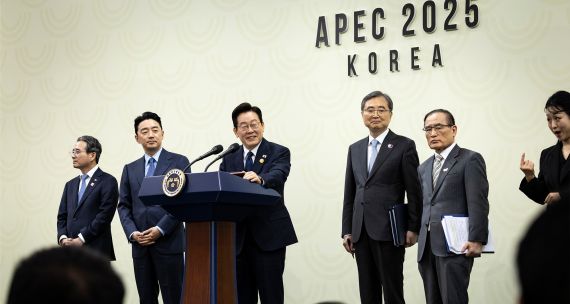Note introductive par Vina Nadjibulla, vice-présidente chargée de la recherche et de la stratégie, FAP Canada
Les élections canadiennes étant désormais terminées et le Parti libéral entamant un quatrième mandat consécutif – ce qui est rare –, Ottawa se trouve à un moment charnière pour sa Stratégie pour l’Indo-Pacifique (SIP).

Depuis son lancement en novembre 2022, la stratégie a cherché à élargir l’empreinte diplomatique du Canada, à diversifier ses liens commerciaux et à renforcer la coopération en matière de sécurité dans l’ensemble de la région.
La promesse du prochain gouvernement de revoir les politiques étrangères du Canada marque un moment opportun pour s’interroger sur les éléments de la stratégie qui se sont révélés utiles, et ceux qui nécessiteraient une recalibration, à la lumière de l’environnement volatil du monde actuel.
Il est essentiel d’évaluer dans quelle mesure la stratégie a effectivement fait progresser les intérêts canadiens dans une région caractérisée par la concurrence entre grandes puissances.
Parallèlement, Ottawa devra concilier deux impératifs : réduire la surdépendance envers les États-Unis (en développant des partenariats plus profonds dans l’Indo-Pacifique et en Europe), tout en négociant une nouvelle entente économique et sécuritaire avec ses alliés les plus proches.
La priorisation efficace, ainsi que le renforcement des capacités et des aptitudes à exécuter à travers le gouvernement et la société, seront critiques. Si les États-Unis étaient historiquement notre meilleur partenaire, tant sur le plan géographique que stratégique, le Canada ne peut plus se permettre des dérives stratégiques. L’engagement avec le Japon, la Corée du Sud, Taïwan, les Philippines et l’Association des nations de l’Asie du Sud-Est (ANASE) n’a jamais été aussi pertinent. De même, rebâtir les relations avec l’Inde et gérer des relations complexes avec la Chine exigera une diplomatie soutenue et nuancée.
Ces réflexions posent les fondements pour l’identification des priorités et la multiplication des réussites, et tracent la voie afin que la Stratégie du Canada pour l’Indo-Pacifique devienne un instrument cohérent d’influence, de prospérité et de sécurité.
Nos quatre premières contributions posent les fondations, tandis que deux nouveaux essais approfondissent la réflexion.
- L’agrégé supérieur de recherches Patrick Leblond positionne les engagements du Canada dans l’Indo-Pacifique par rapport à ses relations avec les États-Unis, l’Union européenne et le Royaume-Uni, offrant une lecture complète de notre positionnement stratégique.
- L’agrégé supérieur de recherches Stephen Nagy analyse les relations Canada-Asie, mettant en lumière les avancées en matière de coopération sur les minéraux critiques, tout en soulignant les opportunités manquées en raison de distractions internes et américaines.
- L’agrégé supérieur de recherches Karthik Nachiappan plaide pour une réinitialisation urgente des relations Canada-Inde, après qu’elles sont passées de prometteuses à critiques.
- Le chercheur en études indo-pacifiques Don McLain Gill met en avant le partenariat de défense entre le Canada et les Philippines comme un succès de la SIP et partage des recommandations pour approfondir cette relation stratégique.
- L’agrégé supérieur de recherches Kai Ostwald explore les opportunités uniques offertes au Canada en Asie du Sud-Est, soulignant la nécessité de recalibrer notre approche pour répondre aux priorités changeantes de la région et aux opinions nuancées sur la Chine.
- L’attaché supérieur de recherche émérite Yves Tiberghien plaide pour une deuxième version de la SIP, progressant sans apport extérieur, appelant le Canada à bâtir une coalition avec le Japon, la Corée du Sud, l’Australie et les partenaires européens pour défendre la primauté d’un ordre mondial et renforcer nos atouts économiques et sécuritaires en amont du sommet du G7 en juin.
D’autres contributions suivront dans les jours et semaines à venir sur les relations Canada-Chine, Canada-Taïwan, le Nord-Pacifique et d’autres dimensions critiques pour la stratégie du Canada pour l’Indo-Pacifique.
Patrick Leblond : Du rapprochement au réalignement : le pari audacieux avec l’Europe et l’Asie
En mars, tout juste après qu'il est devenu devenu premier ministre du Canada, Mark Carney s’est rendu à Londres pour rencontrer le premier ministre britannique Keir Starmer, puis à Paris pour s’entretenir avec Emmanuel Macron, le président français. Ces rencontres visaient à souligner l’importance des relations économiques et sécuritaires du Canada avec l’Europe, à la lumière des menaces et actions émanant de l’administration américaine du président Donald Trump. Si les États-Unis ne sont plus un allié de confiance, le Canada doit alors renforcer ses liens avec des partenaires fiables.
Que signifierait un rapprochement avec l’Europe pour les relations du Canada avec ses alliés de l’Indo-Pacifique ? Serait-ce la fin de la stratégie indo-pacifique du Canada ? Si le Canada devait composer avec des États-Unis belliqueux, tout en négociant une nouvelle entente commerciale pour maintenir son accès au marché américain et en renforçant la coopération économique et sécuritaire avec l’Union européenne et le Royaume-Uni, il risquerait de manquer de ressources – temps, personnel et fonds – pour investir dans la région déjà négligée de l’Indo-Pacifique, annulant ainsi les modestes progrès réalisés ces dernières années. Ce serait une erreur de la part du Canada.
Le premier ministre Carney s’est d’abord tourné vers l’Europe et le Royaume-Uni, qui se trouvent dans une situation similaire à celle du Canada, puisque ces relations pourraient être les plus utiles pour faire face aux États-Unis.
Bien que l’Europe soit moins dépendante économiquement des États-Unis que le Canada, elle fait face à des enjeux sécuritaires plus graves en raison de la Russie.
Pour l’instant, il est difficile pour le Canada de s’engager avec le Japon, la Corée du Sud et les pays de l’Association des nations de l’Asie du Sud-Est (ANASE) à contre-courant des États-Unis. Ces pays indo-pacifiques n’ont pas, jusqu’à présent, décidé de réduire leur dépendance envers les États-Unis. Leur défi géostratégique, contrairement à celui du Canada et de ses partenaires européens, fait qu’ils ont besoin des États-Unis pour maintenir un équilibre face à la Chine. C’est pourquoi ils cherchent à sécuriser leurs relations avec les États-Unis, ce qui explique leur absence de réaction face aux tarifs réciproques et aux droits sur les automobiles imposés par Trump. Les mêmes impératifs sécuritaires s’appliquent à l’Australie et à la Nouvelle-Zélande.
Pour le Canada, cela signifie que ses partenaires indo-pacifiques sont moins prioritaires que ceux de l’Europe, surtout si l’on souhaite réduire notre dépendance économique et sécuritaire envers les États-Unis. Cependant, renforcer notre coopération avec les alliés européens ne devrait pas se faire au détriment de nos relations avec les partenaires indo-pacifiques.
Dans un monde qui se dirige rapidement vers l’établissement de sphères régionales dominées par trois grandes puissances illibérales (Chine, Russie, et désormais les États-Unis), le Canada et ses alliés libéraux-démocrates en Europe, dans l’Indo-Pacifique et en Amérique latine devraient travailler ensemble pour former un contre-mouvement.
Ce mouvement devrait se concentrer sur l’expansion des liens économiques entre ses membres afin de contourner les trois grandes puissances, coordonner les efforts pour réduire la dépendance sécuritaire de ses membres envers les États-Unis, et maintenir les institutions internationales qui soutiennent l’ordre international fondé sur les règles. Autrement dit, ce contre-mouvement devrait protéger les économies et la sécurité de ses membres, et offrir une alternative au reste du monde souhaitant ne pas être assujetti aux grandes puissances.
Le Canada, l’UE et le Royaume-Uni sont les mieux placés pour diriger ce contre-mouvement, autrement dit, pour créer leur propre sphère d’influence. En plus de travailler à renforcer leurs liens économiques et sécuritaires, ils devraient aussi coordonner leur engagement avec leurs partenaires indo-pacifiques. Par exemple, ils pourraient collaborer pour accélérer l’adhésion de l’UE au PTPGP. Cela pourrait se faire relativement facilement, puisque l’UE a déjà des accords commerciaux avec plusieurs pays signataires du PTPGP. De plus, ce groupe de partenaires pourrait explorer comment rendre tous les accords que l’UE, le Royaume-Uni et le Canada détiennent avec les pays de l’Indo-Pacifique interopérables, par exemple en facilitant le cumul des règles d’origine.
En revanche, pour que les pays de l’Indo-Pacifique acceptent de réduire leur dépendance sécuritaire envers les États-Unis, le Canada et ses partenaires européens devront mettre sur la table des ressources de grande ampleur. Même si le Canada, l’Europe, le Japon, la Corée du Sud et d’autres alliés indo-pacifiques voudront maintenir leur coopération en matière de défense et de sécurité avec les États-Unis aussi longtemps que possible, ils devraient également commencer à collaborer étroitement pour bâtir leur propre alliance de sécurité avec des ressources coordonnées et partagées, car les garanties américaines ne sont plus aussi fiables qu’auparavant. Comme l’a souligné Philippe Lagassé, professeur associé à l’Université Carleton : « Planifions pour le pire, mais espérons le meilleur. »
Pour le Canada, cela signifie investir massivement dans sa sécurité et sa défense. Les engagements en matière de défense dans la stratégie indo-pacifique du Canada constituent un bon début, mais convaincre des pays comme le Japon, la Corée du Sud, l’Australie et même des alliés européens que le Canada est un partenaire de sécurité fiable nécessiterait plus de ressources que d’atteindre le minimum requis de 2 % du PIB en dépenses de défense de l’OTAN.
Compte tenu de sa position géographique entre l’Europe et l’Indo-Pacifique, le Canada est bien placé pour jouer un rôle de leader dans la création d’une sphère d’influence « ouverte et libre », pour reprendre les mots de l’ancien premier ministre japonais Abe Shinzo, permettant aux démocraties libérales entre l’Europe et l’Indo-Pacifique de faire face à la Chine, à la Russie et aux États-Unis.
En ce qui concerne les ressources, le Canada n’a pas d’autre choix que de les développer. Comme pour ses partenaires libéraux-démocrates en Europe et dans l’Indo-Pacifique, les actions de l’administration Trump et son approche fondée sur la force représentent une menace existentielle pour l’économie, la sécurité et la souveraineté du Canada. En conséquence, le Canada doit tout donner, comme si demain n’existait plus. C’est son moment Spoutnik, et cela nécessite un pari audacieux.
Stephen Nagy: Le Canada et le Japon : Un partenariat sous-développé et égaré
L’évolution des relations entre le Canada et le Japon dans le cadre de la Stratégie canadienne pour l’Indo-Pacifique constitue une étude de cas d’un potentiel inexploité et d’occasions manquées. Bien que les deux pays partagent des intérêts nationaux communs dans la préservation d’un ordre mondial fondé sur les règles et la démocratie, la relation a connu des avancées notables, mais demeure limitée par les turbulences politiques internes des deux côtés et par l’imprévisibilité des États-Unis, particulièrement avec le retour de Donald Trump à la Maison-Blanche en janvier.
La Stratégie du Canada pour l’Indo-Pacifique de 2022 identifie à juste titre l’importance des ambitions régionales d’Ottawa. Des réalisations concrètes ont vu le jour, notamment l’Accord de coopération Canada–Japon sur les minéraux critiques de 2023, qui représente une étape cruciale vers la sécurisation des chaînes d’approvisionnement pour les batteries de véhicules électriques et les technologies avancées.
Ottawa a également déployé ses navires militaires dans la régionpour soutenir le renforcement des sanctions imposées par les Nations unies à la Corée du Nord dans le cadre de l’« Opération NEON », et a mené des patrouilles maritimes conjointes ainsi que des exercices multilatéraux avec des partenaires tels que les États-Unis, l’Australie et les Philippines dans l’est de la mer de Chine méridionale. Le Canada continue également de contribuer aux questions de sécurité avec le Japon à travers l’« Opération HORIZON ».
De plus, la présence maritime du Canada dans l’Indo-Pacifique a été renforcée par la participation du NCSM Vancouver à plusieurs exercices conjoints, dont KEEN SWORD avec le Japon et RIMPAC 2024, auxquels se sont ajoutés des ressources et du personnel canadiens supplémentaires. Cet engagement maritime, qui se poursuit avec le déploiement du NCSM Ottawa en novembre 2025, démontre la volonté du Canada de renforcer l’interopérabilité avec le Japon et d’autres partenaires régionaux à travers des exercices navals conjoints réguliers et des visites de ports.
Les relations commerciales entre le Canada et le Japon sont restées résilientes, en partie grâce à la mise en œuvre de l’Accord de partenariat transpacifique global et progressiste (PTPGP), dont les deux pays sont membres. Selon Exportation et développement Canada, le commerce bilatéral a atteint 35 G$ CA en 2023, malgré les perturbations causées par la pandémie et les turbulences protectionnistes. Le PTPGP a efficacement créé l’architecture institutionnelle pour une intégration économique approfondie tout en offrant aux deux pays une certaine protection contre les tactiques commerciales imprévisibles de Trump.
Cependant, ces réalisations ne représentent qu’une fraction du potentiel de collaboration. L’approche du Canada a été marquée par des retards et des incohérences regrettables. Lorsque Justin Trudeau, alors premier ministre, a prorogé le Parlement en janvier 2025 alors que sa popularité était en déclin, les accords bilatéraux en suspens sur la cybersécurité et le partage de renseignements ont été mis de côté pour une durée indéterminée. Cette réinitialisation parlementaire a freiné l’élan, alors qu’une mise en œuvre immédiate était pourtant nécessaire. Comme l’a confié un ancien diplomate canadien à Tokyo, « lorsqu’Ottawa a mis sur pause, Tokyo a douté de notre sérieux. »
Du point de vue japonais, la position politique précaire du premier ministre Ishiba Shigeru a également freiné les initiatives ambitieuses. À la tête d’une coalition fracturée avec un taux d’approbation inférieur à 24 %, Ishiba s’est principalement concentré sur les réformes économiques internes, tout en limitant les engagements internationaux susceptibles de rencontrer l’opposition parlementaire. En conséquence, l’expansion attendue de la collaboration en matière de technologies de sécurité, prévue par la stratégie nationale de sécurité du Japon de 2022, n’a été que très partiellement réalisée.
Les deux pays ont dû consacrer leurs ressources diplomatiques à la gestion de leurs relations avec Washington. Le rétablissement de tarifs sur l’aluminium et l’acier canadiens en février 2025, ainsi que les menaces pesant sur les exportations automobiles japonaises, ont poussé Ottawa et Tokyo à adopter des positions réactives. L’expansion de la présence diplomatique, longtemps planifiée dans l’Indo-Pacifique et élément central de la stratégie canadienne, a été reportée à plusieurs reprises, les ressources étant réaffectées à la gestion de la crise sur le continent nord-américain.
Ce qui manque de façon flagrante, c’est un cadre global de sécurité entre le Canada et le Japon, allant au-delà d’une coopération fragmentée. L’Australie et le Japon ont signé un ccord d’accès réciproque en 2022, alors que la coopération Canada-Japon continue de s’appuyer sur des solutions au cas par cas plutôt que sur des canaux institutionnalisés. Des lacunes subsistent malgré des préoccupations partagées concernant l’affirmation croissante de la Chine dans les eaux contestées et des intérêts communs pour le maintien de la liberté de navigation.
La coopération énergétique représente une autre occasion manquée. Le Canada dispose de ressources naturelles abondantes qui pourraient renforcer la sécurité énergétique du Japon dans un contexte géopolitique incertain, mais les obstacles réglementaires et les limitations d’infrastructures ont empêché le gaz naturel liquéfié canadien d’atteindre le marché japonais à grande échelle. Le projet Kitimat GNL, qui aurait pu positionner le Canada comme fournisseur fiable, continue de connaître des retards que les partenaires japonais trouvent frustrants.
La coordination des politiques à l’égard de la Chine demeure également sous-développée. Bien que les deux pays soient devenus plus vigilants envers Pékin, il est rare qu’ils synchronisent leurs réponses diplomatiques aux provocations régionales. Lorsque la Chine a mené de vastes exercices militaires autour de Taïwan, à la suite de visites de membres du Congrès américain à la mi-2023, les déclarations du Canada et du Japon différaient sensiblement tant sur le fond que sur la forme. Ce manque de coordination minimise l’effet dissuasif que peuvent avoir les puissances moyennes lorsqu’elles agissent de concert.
La gouvernance numérique est un autre domaine prometteur mais encore peu développé de la collaboration. Les deux pays partagent des valeurs démocratiques dans la régulation des technologies, mais ils n’ont pas su établir de normes et d’approches conjointes pour la protection des données, qui pourraient pourtant contrer l’autoritarisme numérique chinois.
Allant de l'avant, un partenariat recalibré entre le Canada et le Japon exige une volonté politique de dépasser les distractions domestiques et l’attraction gravitationnelle de l’imprévisibilité américaine. Trois priorités devraient guider ce renouveau :
1. Institutionnaliser la coopération en matière de sécurité à travers un cadre bilatéral formel, plutôt que de dépendre uniquement des mécanismes régionaux ou multilatéraux.
2. Accélérer la collaboration sur les minéraux critiques et les écotechnologies avec des investissements concrets dans les infrastructures, plutôt que de se contenter d’accords déclaratifs.
3. Développer des approches synchronisées face à la coercition économique des grandes puissances, au-delà d’une solidarité purement rhétorique.
En tant que puissances moyennes évoluant dans une architecture régionale complexe, le Canada et le Japon partagent des intérêts communs dans le maintien d’un ordre mondial fondé sur les règles. Cette relation possède les éléments constitutifs d’un partenariat stratégique majeur, mais sa concrétisation exige une attention politique soutenue, qui s’est jusqu’à présent révélée insaisissable en raison des turbulences internes et de l’imprévisibilité américaine.
Karthik Nachiappan: Relations Canada-Inde : en route vers le meilleur ?
Le nouveau gouvernement à Ottawa réviserait les politiques canadiennes envers l’Asie et réfléchirait aux meilleures manières de poursuivre la stratégie du Canada pour l’Indopacifique initiée par l’ancien premier ministre Justin Trudeau. Cette politique visait à réorienter l’approche d’Ottawa dans la région pour la rendre plus stratégique. Ce qui ne s’est pas passé comme prévu. La motivation pour la stratégie et ses résultats espérés a été amoindrie par une liste de tâches relevant de politiques paroissiales et d’événements inattendus, particulièrement la crise diplomatique et la dispute avec l’Inde, ce qui a retiré l’« Indo » de la stratégie indo-pacifique. Il est relativement clair que le prochain gouvernement devra recalibrer cet outil en réparant les relations avec l’Inde.
Cela serait-il possible ?
Il est difficile de prédire les prochaines phases dans les relations Canada-Inde. Les dernières années n’ont pas été sans difficultés. La relation demeure perturbée, et les efforts pour la rétablir ont été agités, apportant des révélations dommageables qui ont mis fin à un équilibre bilatéral précaire. Cependant, il existe deux raisons expliquant pourquoi les deux pays ont atteint un plafond.
Premièrement, le contexte international a changé. L’agression de l’administration Trump sur l’ordre et l’économie mondiaux, ainsi que la réponse calme et résolue de la Chine, ont convaincu les pays de chercher un espace diplomatique et une marge de manœuvre, relançant les relations existantes et celles inactives. Cette situation offre au Canada et à l’Inde la possibilité de réinitialiser leurs liens et de négocier un nouveau cadre d’entente autour des intérêts prioritaires, comprenant essentiellement le commerce et les investissements.
Delhi et Ottawa devront trouver comment collaborer autour de cette recalibration économique et de sécurité mondiale imposée par les États-Unis. Washington était pour les deux pays un partenaire stratégique indispensable, créant et maintenant des partenariats basés sur la défense, la sécurité, le commerce et l’investissement. Cet arrangement, cependant, sera renégocié.
Delhi et Ottawa ont également besoin de plus d’accès au marché pour des biens et services spécifiques, alors que l’accès au marché des États-Unis s’atténue et devient moins fiable. Les deux pays doivent renforcer leurs accords sécuritaires en Asie, en Europe et en Amérique du Nord, compte tenu des doutes par rapport aux engagements américains. Delhi a besoin de capitaux, d’énergie et de technologies pour pallier le déclin possible des investissements américains, tandis qu’Ottawa espère diversifier davantage ses partenaires commerciaux, alors que la pression s’intensifie pour réorganiser l’économie domestique du Canada.
Il y aura toujours un besoin de prévisibilité dans l’investissement, les technologies et les produits pour soutenir la croissance de l’Inde, créant des opportunités et des débouchés pour le capital, l’énergie et les ressources du Canada. Les perspectives pour une réinitialisation bilatérale semblent positives, avec le commerce et l’investissement en augmentation malgré la crise dans les relations militaires. Les conditions paraissent propices à une réinitialisation, nonobstant l’aspect politique.
Deuxièmement, Delhi négocie une entente pour éviter les pires effets des tarifs douaniers de Trump tout en se protégeant des États-Unis en élargissant ses partenariats diplomatiques. Ces derniers mois, le gouvernement de M. Modi a rouvert les négociations commerciales avec l’Union européenne, a approfondi les liens avec les principaux partenaires européens, s’est progressivement orienté vers la Chine, s’est reconnecté avec la Russie, s’est engagé plus ouvertement avec l’Asie du Sud-Est, a renouvelé les discussions de connectivité avec ses voisins et a conclu des ententes avec les pays du Golfe.
L’Inde cherche à naviguer cette agitation dans le système international en cherchant à avoir plus de partenaires et en ratifiant de nouvelles ententes pour créer un environnement suffisamment stable pour son développement et sa croissance économique. Delhi devra probablement gérer ce remaniement tout en restant prudent vis-à-vis de la Chine, cependant Pékin cherche à consolider sa centralité en Asie du Sud et du Sud-Est.
Le présent scénario crée des opportunités pour la plupart des pays d’être diplomatiquement flexibles et de solidifier et élargir leurs possibilités stratégiques, alors qu’ils renégocient les partenariats qui peuvent être améliorés avec les États-Unis et la Chine. L’Inde serait donc sur la bonne voie. Qu’en est-il pour le nouveau gouvernement canadien ?
Don McLain Gill: The Emerging Philippines-Canada Defence Partnership
When Canada launched its Indo-Pacific Strategy in November 2022, it aimed to bolster its diplomatic presence and contribute to the region's security, sustainability, and growth by co-operating with like-minded partners. One of the strategy’s undeniable successes is the exponential growth of Canada’s security partnership with the Philippines. It is vital for the newly elected government in Ottawa to invest more in this relationship to better position it as a fulcrum for Canada’s Indo-Pacific vision.
Operationalizing the Philippines-Canada Defence Partnership
In recent years, the Philippines and Canada have strengthened their interoperability and preparedness co-operation in the maritime domain. In September 2023, the two navies conducted a joint sail activity in the West Philippine Sea. This significantly contributed to the Philippines' efforts to engage like-minded partners in ensuring that its maritime zones remain free, open, and rules-based. Such activities complement Canada's commitment to a free and open Indo-Pacific by collaborating with partners based on Operation Horizon.
In October 2023, Ottawa and Manila signed an agreement that gives the Philippines access to Canada’s satellite-based technology to detect dark vessels — that is, ships that turn off their location transmitter. For the Philippines, this assistance is crucial, especially at a time when China's maritime militia and the China Coast Guard (CCG) have been engaging in coercive and illegal activities in Philippine waters. More importantly, China's use of grey-zone tactics makes it difficult for the Philippines to effectively monitor all activity taking place in its waters; thus, Canada has shown that it has a mature understanding of Manila’s acute security concerns at sea. Since the agreement became operational, the Philippine Coast Guard (PCG) has enhanced its capability to track the activities of the CCG and its paramilitary ships in Philippine waters.
Demonstrating a willingness to further deepen the bilateral security relationship, Manila and Ottawa signed a Memorandum of Understanding (MoU) for Defense Cooperation in January 2024. In addition to Canada committing to invest more in its security partnership with the Philippines, the MoU provides a roadmap for bilateral defence collaboration in the region and has opened doors for Canada to position itself more effectively in the region’s emerging geopolitical dynamics and to collaborate with other like-minded Indo-Pacific partners.
In June 2024, Canada joined its first multilateral maritime cooperative activity (MMCA) with the Philippines, Japan, and the United States in the West Philippine Sea. Two months later, it participated in another MMCA with the Philippines, the U.S., and Australia in Philippine waters. In February 2025, Canada joined the Philippines and the U.S. in a joint military exercise in the waters of Northern Luzon. In addition to asserting freedom of navigation and upholding the 2016 Arbitral Award, Canada’s frequent participation in these multilateral maritime activities provides an opportunity for Ottawa to be more strategically involved in operational exercises in critical zones of the Indo-Pacific to enhance co-ordination and interoperability with like-minded partners.
Furthermore, in March, the Philippines and Canada concluded negotiations for the Status of Visiting Forces Agreement (SOVFA). Once signed and ratified, the SOVFA will enable Canada to rapidly deploy its troops to the Philippines for disaster relief and humanitarian assistance — a key element in its Indo-Pacific Strategy. Additionally, the SOVFA will catalyze more robust Canadian participation in various exercises for which it has thus far been an observer, such as the Balikatan Exercise between the Philippines and the U.S. and Exercise ALON between the Philippines, the U.S., and Australia.
Maximizing the Potential of the Philippines-Canada Defence Partnership
In the past two years, Canada has demonstrated its reliability as a capacity-builder and trusted partner. However, bilateral ties must continue to evolve in response to the turbulent realities of regional geopolitics.
First, Canada needs to invest more in cybersecurity co-operation. The Philippines continues to be one of the most targeted nations vis-à-vis China-backed online information campaigns and malign information operations that seek to exploit information flows and create domestic discord against the current Filipino government’s security policies in its maritime zones. With its cybersecurity expertise, Canada is in a favourable position to operationalize its Indo-Pacific Strategy's focus on building cyber-resilience by assisting the Philippines in enhancing its cyber-defence capabilities. If it succeeds, the Philippines-Canada model can be emulated by Ottawa with other Southeast Asian countries that are also increasingly vulnerable to cyberattacks.
Second, Canada must increase the frequency of its bilateral and multilateral maritime activities with the Philippines. However, doing so will depend on whether Ottawa can maintain or even increase its naval presence in the Indo-Pacific. While Canada earlier deployed an additional ship to the Indo-Pacific, there are concerns about whether it will be able to sustain this in the long term, a concern expressed by then-Canadian Chief of Defence Staff General Wayne Eyre in November 2023. Hence, the newly elected Canadian government must prioritize the modernization of the management of its surface ships if it intends to maintain its position in the Indo-Pacific.
Third, Canada will need to improve how it brands its Indo-Pacific Strategy. One of the most common misperceptions about Ottawa's vision is that it is Western-oriented and largely reflective of U.S. interests in the Indo-Pacific. While a strong bilateral foundation rooted in deep people-to-people relations, shared values, and economic ties has allowed Canada and the Philippines to make up for lost time in the security dimension of their relationship, Ottawa would need to make more of an effort to engage with other regional countries that are becoming increasingly wary of the U.S.-China power competition. Therefore, Canada will have to demonstrate its agency in articulating its distinct vision for the Indo-Pacific. Consequently, Ottawa's current trade tensions with Washington may serve as an opportunity for Canada to redefine its image in the Indo-Pacific. Doing so will position Canada more favourably in the region.
Kai Ostwald: From Momentum to Meaning: Canada’s Strategic Opening in Southeast Asia
Southeast Asia’s interest in Canada has rarely — if ever — been as strong as it is today. Some of that stems from the momentum generated by Canada’s increased presence in the region under Ottawa’s 2022 Indo-Pacific Strategy (IPS).
Geopolitics, however, play at least as significant a role. Southeast Asia remains highly dependent on the United States; with Washington’s role in flux, the desire to strengthen engagement with Canada — the U.S.’s closest neighbour — has grown. This moment presents a distinct opportunity for Canada to solidify its role as a reliable and relevant partner in Southeast Asia’s evolving strategic landscape. Capitalizing on it will require not only sustaining the momentum of recent years but also recalibrating Canada’s approach to reflect the region’s shifting positions and priorities.
Canada has done several things right since launching the IPS. High-level visits by Canadian leaders and sustained participation in ASEAN‑-led forums have been widely noted, as have the trade and education missions aimed at deepening economic and institutional ties. Targeted initiatives — such as the dark vessel detection collaboration with the Philippines and support for democratization in Myanmar — have generated goodwill and demonstrated Canada’s value as a close and capable partner. These efforts must be sustained if Canada is to reap the benefits of deeper diversification, particularly given its lingering reputation as a fair-weather‑ actor prone to retreat following political shifts in Ottawa.
For a middle-sized country like Canada, favourable external conditions are often as important as policy in enabling meaningful breakthroughs. The U.S.’s inward turn under ‘Trump 2.0’ has generated uncertainty and crisis around the world, which Canada has experienced firsthand. Painful as they are, such moments can also create openings. In this case, they have generated a level of interest in Canada across Southeast Asia that surpasses what years of deliberate outreach have produced. Some of this reflects the hope that Canada, by virtue of its deep ties and proximity to the U.S.‑, can help make sense of Washington’s unpredictable turns. Even if Canada cannot offer clarity on the path ahead, many in the region want it at the table as an interlocutor and sounding board while they navigate the turbulence that Trump 2.0 has unleashed.
Interest in Canada for its own sake has grown as well. The vacuum left by the U.S. inward turn — and anxiety about how it might be filled — has led many in the region to seek alternative partners. Canada, while not a substitute for the U.S., is generally seen as safe, relatively free of geopolitical baggage, and unlikely to impinge on Southeast Asia’s interests in the way some larger powers might. In short, the disruptions triggered by Trump 2.0 have created an unprecedented welcome for Canada to become a more engaged political and economic partner.
Making use of this moment requires not only sustained presence but also a clearer articulation of what Canada brings to the region and a recalibration of some existing approaches. Elements of the IPS closely mirror U.S. language and priorities — especially on security and China — in ways that do not align with the diversity of Southeast Asia’s perspectives. While regional governments are concerned about shifting power balances and Chinese assertiveness, few see value in framing China solely as an adversary. Canada’s concerns with China are legitimate, but its greatest potential in Southeast Asia lies elsewhere: in supporting development, governance, trade, technology, and rules-based co-operation rather than replicating the muscular posture of larger allies. Crucially, this also means stepping beyond the U.S. shadow to ensure Canada is not dismissed as a mere proxy on security issues.
More broadly, Canada’s appeal in Southeast Asia rests in part on shared structural realities. Like many ASEAN member states, Canada must navigate — rather than shape — global power dynamics in ways that preserve the interests of vulnerable states and economies. The pragmatism this calls for offers a firm foundation for mutually beneficial partnerships — more so, at least in Southeast Asia, than the notion of ideological “like-mindedness.” In a region shaped by colonial legacies and great power‑ rivalry, Canada’s profile as a globally relevant, industrialized country that is neither a superpower nor a former colonizer is particularly attractive.
A planned foreign policy review under a new, Mark Carney-led government provides an opportunity for Canada to clarify priorities and address gaps. That includes ensuring the IPS reflects Southeast Asia’s diversity and strategic importance and that institutional capacity exists to follow through on growing interest from the region. Canada’s global engagements have long tilted toward transatlantic ties — an understandable bias given the background of many in the current government. Southeast Asia offers a different kind of strategic value: not only as an engine of growth but also as a partner that aligns with Canada’s long-term diversification and global engagement‑ goals.
The IPS has opened doors. The new Liberal government now has a unique opportunity to make significant gains in its diversification ambitions by walking through them in a deliberate and consistent manner — calibrated to Southeast Asia’s perspectives.
Yves Tiberghien: The Urgent Need for a Bootstrapped and Strategic Indo-Pacific Strategy 2.0
Since the release of Canada’s Indo-Pacific Strategy in 2022, the geo-strategic and geo-economic contexts have changed greatly. While the security risks induced by a more assertive China persist, the dominant theme of 2025 has been the Trump 2.0 administration’s abrupt and unilateral takedown of the global rules-based order, including launching the most comprehensive and multi-dimensional trade war since the 1930s. Canada, given its 77 per cent export dependence on the U.S., faces both the most direct threat to its economic stability in the post-war period and the most serious threat to its sovereignty since the 19th century. 2025 is the year of mega disruption for the world, but especially for Canada.
In this context, Canada needs an upgraded and bootstrapped version 2.0 of its Indo-Pacific Strategy (IPS). This should include a multilateral campaign to work with non-U.S. allies to save the rules-based order from great powers, a much greater security investment as a source of leverage, and a strategic approach to economic prosperity and economic security. The core group of multilateral allies must begin with Japan, South Korea, and Australia, as well as the European Union and the U.K. (learning from the experience of the Ottawa group in the first Trump administration), with intense co-operation with ASEAN countries, India, Mexico, and other middle powers as well.
The June G7 meeting will be a critical moment for co-ordination among non-U.S. allies to present a united front – partly co-operative and partly based on principle – in discussions with the U.S. As this year’s G7 Chair, Canada can initiate a stabilization effort to buttress a peaceful, rules-based order that is critical for humanity’s future. To do so, it must leverage the combined strength and unity of the rest of the G7 to limit the unravelling before it is too late. This is extremely tough, and the stakes are high, but it is time for Canada to step out from the shadows and play a strategic role commensurate with its networking power and G7 rank.
Within the Indo-Pacific, Japan and South Korea are the first anchor points for Canada. Japan combines the strategic heft of the fourth economic pole in the global economy (after the U.S., China, and the EU) and the most strategic location in the region, as the host of U.S. power projection in the entire Indo-Pacific. Japan was also chosen by the U.S. as the priority country with which to reach a fast-track comprehensive agreement and is thus the litmus test for the revolutionary Trump 2.0 administration.
As of early April, Japan was the country most ready to concede and bandwagon with the Trump administration. By early May, the overreaching nature of U.S. demands – spanning trade and long-term auto tariffs, Yen re-evaluation, rapid security reinforcements, and a decoupling from China – created a domestic political backlash in Japan. With Prime Minister Shigeru Ishiba facing a tough Upper House election around July 20, he is unable to capitulate and has publicly committed to removing the extremely painful and humiliating U.S. auto tariffs. It is often said that Japan’s auto industry represents, both directly and indirectly, 10 per cent of the country’s entire GDP. So, Japan faces an impasse and is playing a game of chicken. Opposition leader Yoshihiko Noda has already urged Ishiba to ‘go multilateral’ to build leverage in facing down the U.S.
Japan offers important lessons for Canada. First, it shows how the Trump 2.0 administration is seeking comprehensive zero-sum wins and is unwilling to negotiate with its partners. In response, Japanese Finance Minister Katsunobu Kato has started talking about the leverage ‘card’ Japan holds within the U.S. bond market – leverage that played a key role in the U.S.’s April 9 bond market crisis. In other words, it will be impossible for countries like Japan and Canada to reach deals acceptable to their own domestic voters without very credible multilateral leverage, chiefly, the powerful roles they play in the U.S. bond market.
Second, negotiations are comprehensive and include security, currency regimes, and almost every dimension of power. Japan is being forced to start discussing meeting its own security needs without the U.S. and developing a possible nuclear shield. On these issues, Canada must also increase its leverage and autonomy, and an IPS 2.0 must include, as a starting point, a commitment to rapidly reach defence spending of two per cent of GDP. This package should also include a serious demonstration of Canada’s ability to take full control of the Arctic, with networks of censors, submarines on each side of the Northwest Passage, and military bases. The IPS 1.0 was weakened by the fact that new navy deployments were made from a very depleted base. It is now time to invest comprehensively to rebuild the core capacity and attractiveness of the Canadian navy and military as a whole.
Third, we are now in the age of geopolitics and great power politics. Interdependence has been weaponized by the U.S. (and by China and others). Canada must create a strategic economic council under the prime minister’s office to develop strong ‘cards’ to play in this battle. In an age when artificial intelligence will make huge energy demands, Canada’s first strength is its energy resources. The second is critical minerals, fertilizers, and other core resources. However, Canada needs a strategic plan to rapidly develop lithium capacity at scale, with strategic allies such as South Korea and Japan, and with Canadian public investment.
Fourth, the travels of Japanese ministers and elected officials within the first week of May reflect the comprehensive diplomatic engagement that Canada lacks. While Prime Minister Ishiba travelled to key countries in Southeast Asia (Vietnam, the Philippines), other ministers travelled to Indonesia, his foreign minister visited Europe and the UN, and his trade negotiator and others were dispatched to Washington. The ruling party’s Secretary General, meanwhile, took 15 MPs to Beijing in a large diplomatic dialogue, while two former ministers also travelled to Taiwan.
To protect itself, Canada needs a comprehensive global strategic engagement like this that can generate leverage and investments in preventing a cycle of conflict.
In sum, the stakes for Canada are now infinitely higher than in 2022, when it unveiled its first IPS. Canada must actively work to build and expand a coalition of partners in the Indo-Pacific and in Europe and beyond, so as to create critical mass leverage for itself and for the global order.
• Series editors: Erin Williams, Senior Program Manager, Ted Fraser, Senior Editor, Vina Nadjibulla, Vice-President Research & Strategy, APF Canada










